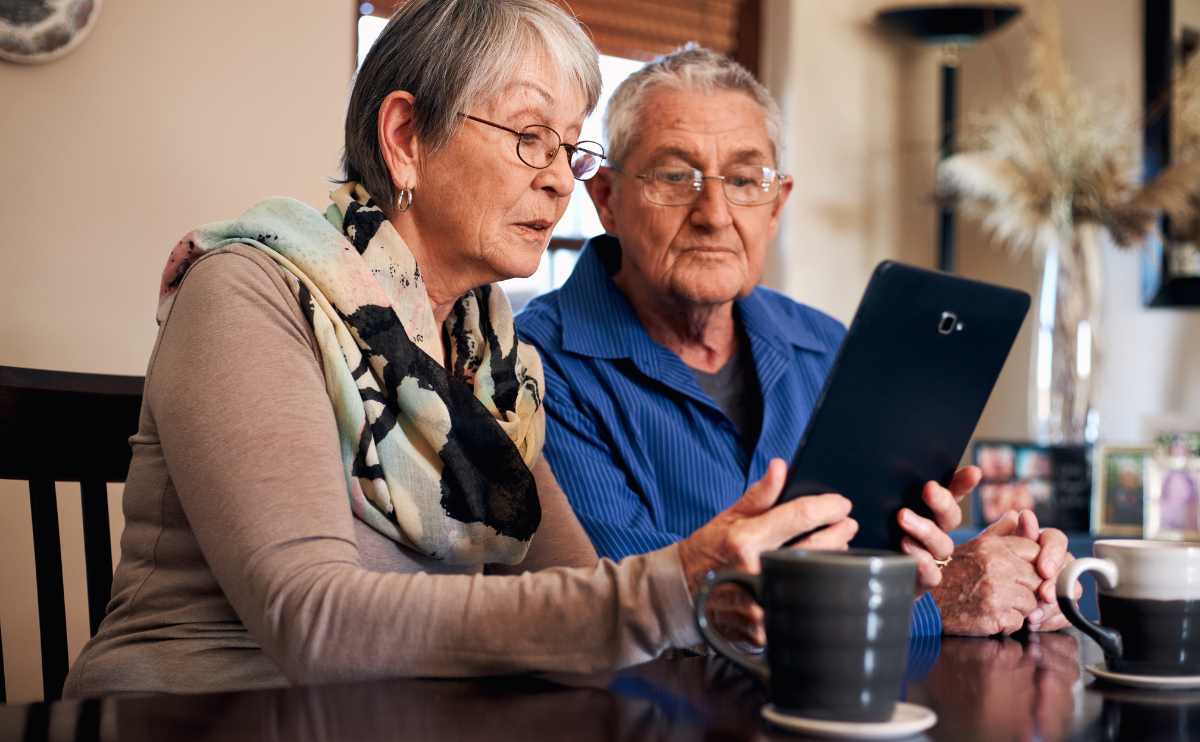Living DNA Review: What Did We Discover From Our Results?
When you purchase through links on our site, we may earn a commission. Here’s how it works.
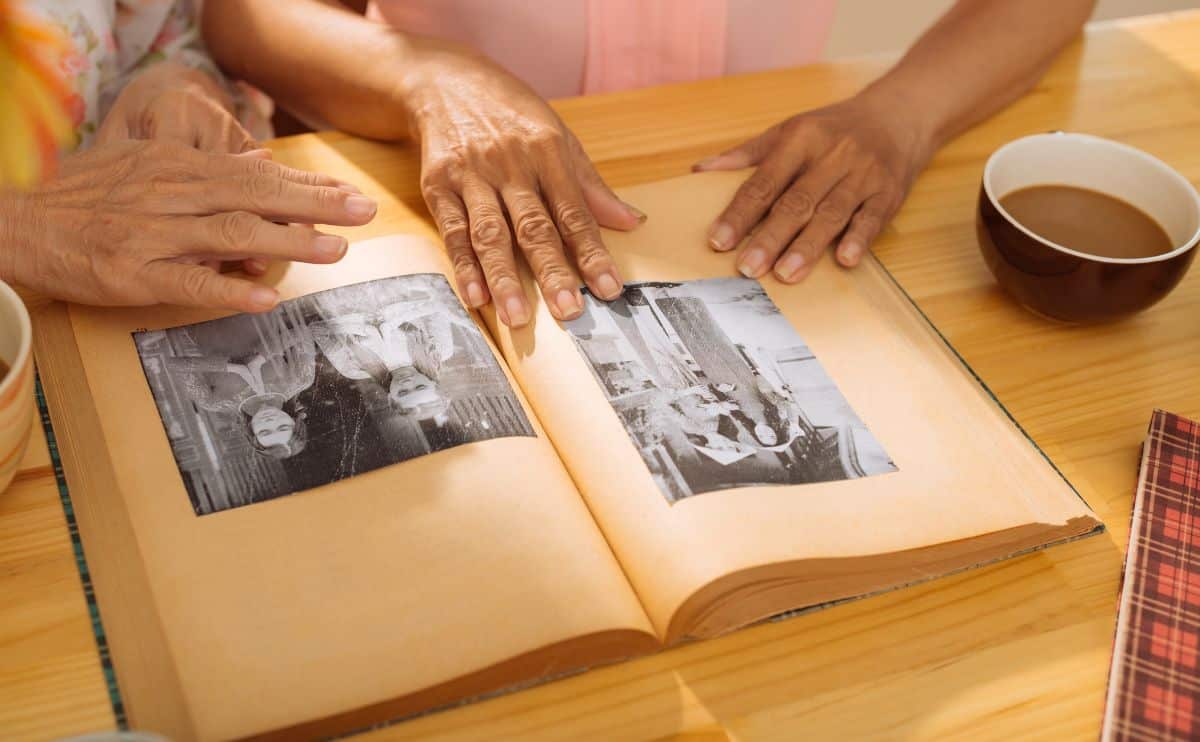
Did you that know a simple swab of your cheek can reveal where your ancestors came from hundreds and thousands of years ago and can help you identify both living and deceased family members? Many sites, including Living DNA, offer direct-to-consumer DNA testing services to give you these answers and more.
Thanks to Living DNA’s ancestry test, one of my team members learned much more about her ancestry and got insights into her living relatives. She shares her personal experience with you here. Also, I have more than a decade of experience researching and testing different DNA tests and genealogical sites, so I’ll delve into what you can expect with Living DNA compared to similar options to decide if this testing service is worth your money.
Product Name: Living DNA
Product Description: Living DNA is a direct-to-consumer DNA testing service that gives you a breakdown of your ethnic mix, your haplogroup(s), DNA matches, and more.
Summary
Living DNA stands out for its ability to break down your ethnicity in British and African locations, but it also includes many other global regions. It’s also one of the very few services to provide your haplogroups from its basic ancestry test. You can learn a lot about your ancient origins — even how much DNA you share with Neanderthals, Vikings, and other ancient populations.
Also with family matching and an optional wellbeing test, Living DNA has a lot to offer. However, it doesn’t have the broad scope that AncestryDNA gives you nor testing for genetic disease risks that you’ll find with 23andMe.
Overall Score
-
DNA Tests Offered
-
Privacy
-
Pricing
-
Customer Support
-
Online Community
Pros
- Excellent for a more in-depth British regional breakdown (20+ subregions)
- Includes 72 genetic population estimates in Africa
- Provides maternal and paternal haplogroups
- Good security and privacy policy
- Ability to upload raw DNA results from AncestryDNA, 23andMe, MyHeritage, and more
- Can download raw DNA data
- Has a new chrosmosome browser
- Offers a DNA health and diet test kit
Cons
- Very small DNA database compared to most services (limits family matching capabilities)
- Lacks a community forum and family tree builder
- Fairly low loading speeds when switching between features in the Family Matching section
- Most other services won’t let you upload LivingDNA raw DNA data
- Results can take up to 2 months
Consumer Reviews
This is the aggregate score of reader reviews we’ve received. Have a good or bad experience with Living DNA? Feel free to leave your own review in the comments. Please note that only ratings with valid review content will be published and counted.
6 Key Features
- One of very few services that analyzes Y-DNA and mitochondrial DNA to give you your haplogroup and haplotype (from an autosomal DNA test)
- Your genetic data results are continuously updated online to provide ongoing analysis by Living DNA’s database
- Living DNA ancestry results give you your ethnicity percentages across 150 world regions, including 21 subregions from the U.K. and Ireland
- Detailed descriptions of various indigenous groups, migration patterns, and DNA groups to help you better understand where you and your family come from
- Offers upgrades to discover how much DNA you share with Neanderthals, Vikings, and other ancient populations
- Can purchase a personalized ancestry book
Pricing
- Ancestry kit: $124
- Ancestry + Neanderthal kit: $145
- Wellbeing kit: $129
- Ancestry & Wellbeing kit: $225
- Free shipping
- View all options
Personal Experience With Living DNA’s Ancestry Test
My team member, Sadie Cornelius, received a Living DNA ancestry test kit in exchange for an honest review. As industry experts in direct-to-consumer DNA ancestry tests, our team at Safe Smart Living jumped at the opportunity to test out their DNA kit ourselves.
I and other Safe Smart Living team members have tested with all the top at-home DNA tests so that we can compare them head-to-head. Here’s Sadie’s personal experience with taking the Living DNA test and how you can view your autosomal DNA results.
Testing Process
The process is simple. All you have to do is provide a saliva sample and mail it into Living DNA with the provided postage-paid envelope. I took the test several years ago, but from what I’ve seen, Living DNA has upgraded its process to give you notifications when you return your sample, when they receive your sample, and updates on their lab analysis. The website currently says you can expect results within six to eight weeks which is about how long it took for my results.
Although I took the test in 2017, I recently logged back into my account to view my updated results based on Living DNA’s ongoing analysis. Here’s a breakdown of what you can currently expect to learn from your results, how Living DNA presents them, and various tools and features.
Living DNA Ancestry Results
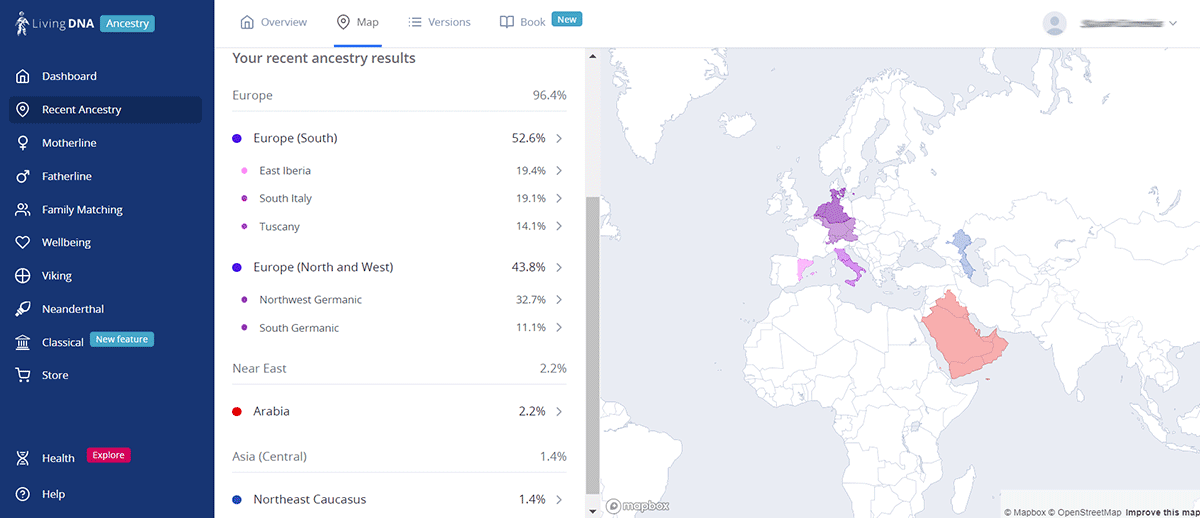
The first place I headed was the Ancestry Results section. I like the detailed breakdown by subregions to give you a deeper dive into where your ancestors came from. These were pretty spot on since I know my family has ties to Germany and Eastern Europe.
However, Living DNA doesn’t include nearly as many geographical regions as AncestryDNA or 23andMe. You can click on each subregion on the map or in the list to get a detailed history about each area and ancient populations.
Motherline & Fatherline
Living DNA is one of very few direct-to-consumer autosomal DNA tests that provides both maternal and paternal haplogroups. What are haplogroups? They’re ancestral groupings of people who share a common ancient ancestor on either their maternal (through mitochondrial DNA) or paternal line (Y-chromosome DNA). Keep in mind that only males have a paternal haplogroup because fatherlines can only be analyzed from a male’s Y-chromosome DNA.
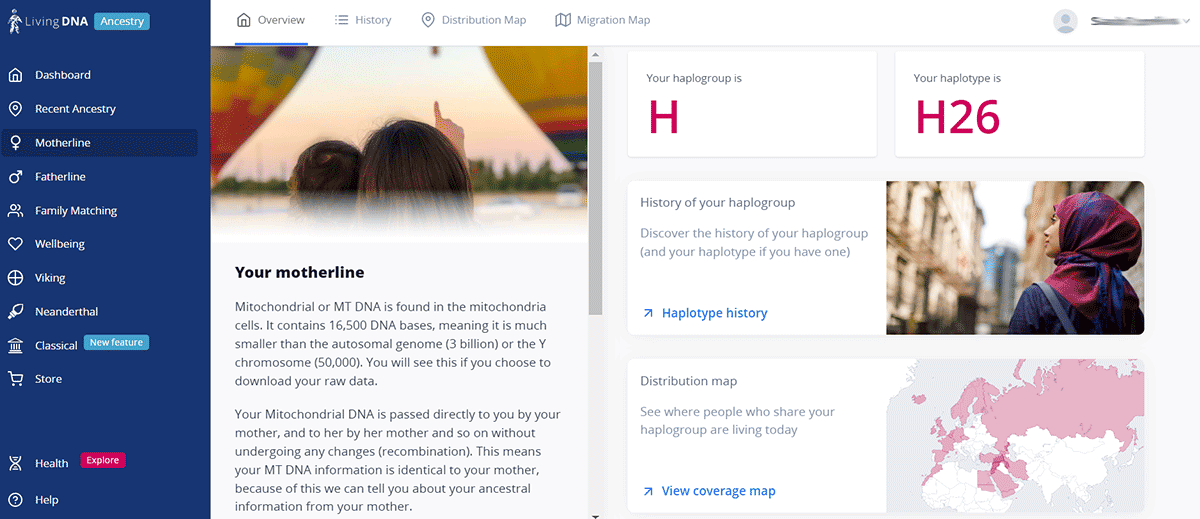
I first clicked on the History sub-section to learn more about my maternal haplogroup H and H26 subclade. (A subclade is a term used to describe a subgroup of a haplogroup.) I learned that my H haplogroup is the most common motherline group across Europe and is believed to have originated in the Ice Age, between 25,000 and 30,000 years ago. The exact place of origin isn’t known for certain, but it most likely arose in or around the northeastern regions of the Mediterranean.
Motherline Distribution Map
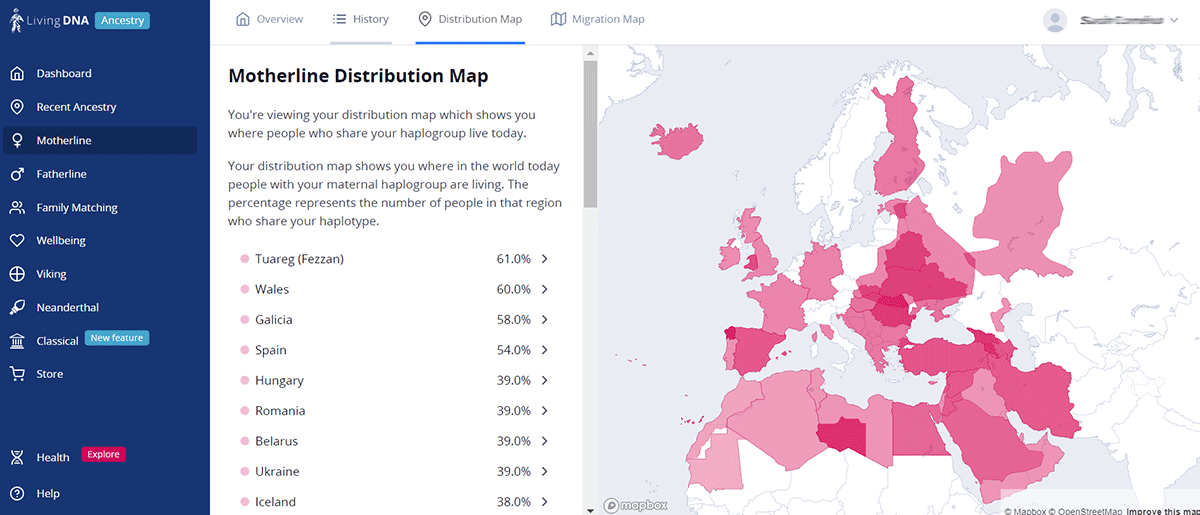
I then headed over to the Distribution Map sub-section, which showed me where people who share my H haplogroup live today. I was surprised to see that the largest group (61%) with whom I share my motherline is the Tuareg population, located in Northern Africa. Living DNA shared a research citation that says it’s likely that the presence of H group in North Africa was due to recolonization from Gibraltar.
The final sub-section in Motherline is a migration map, which shows simple lines of migration patterns for each haplogroup. I found this map pretty underwhelming and not easy to understand the way migration lines are presented. I was also disappointed that you can’t interact with the distribution or migration maps to learn more. Also, I found it puzzling that there was no specific information provided about my subclade H26.
Family Matching
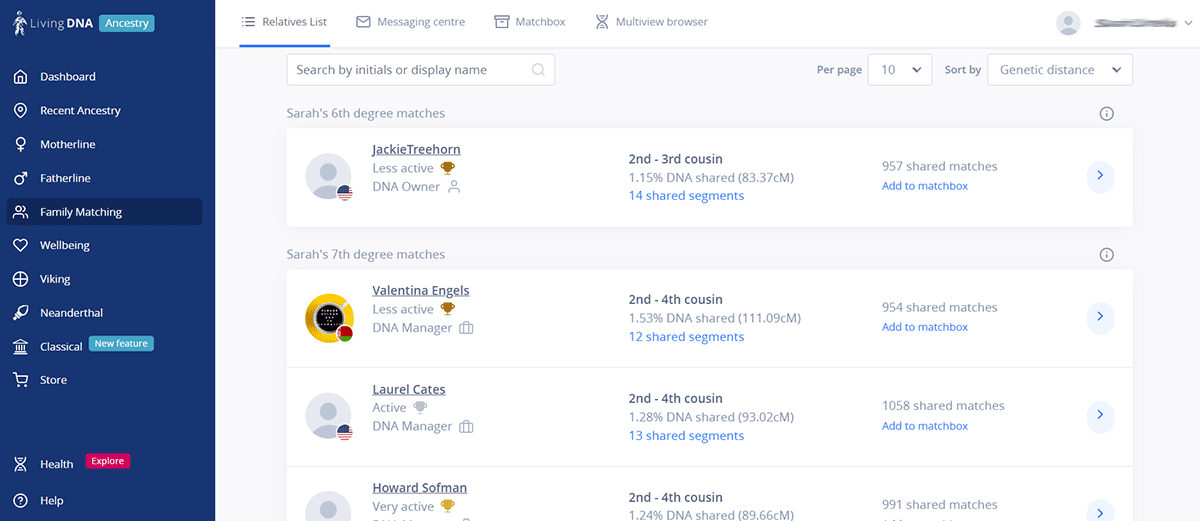
I found the Family Matching section a fascinating way to discover other Living DNA customers who share DNA with me. You can view immediate family members all the way out to 4th cousins and beyond. If you opt into Family Networks, you can message other relatives who have opted in to get in touch.
I dove into this section’s cool features to see the different ways to explore family connections and ancestry. However, I did find that this section has a fairly slow loading speed when you’re switching between features compared to the speed of AncestryDNA and similar services. Still, there’s a lot of fun stuff here. I first clicked on a 2nd-3rd cousin match. This led me to a landing page with several tabs to delve into this family member’s connection to me.
Relationship Tab
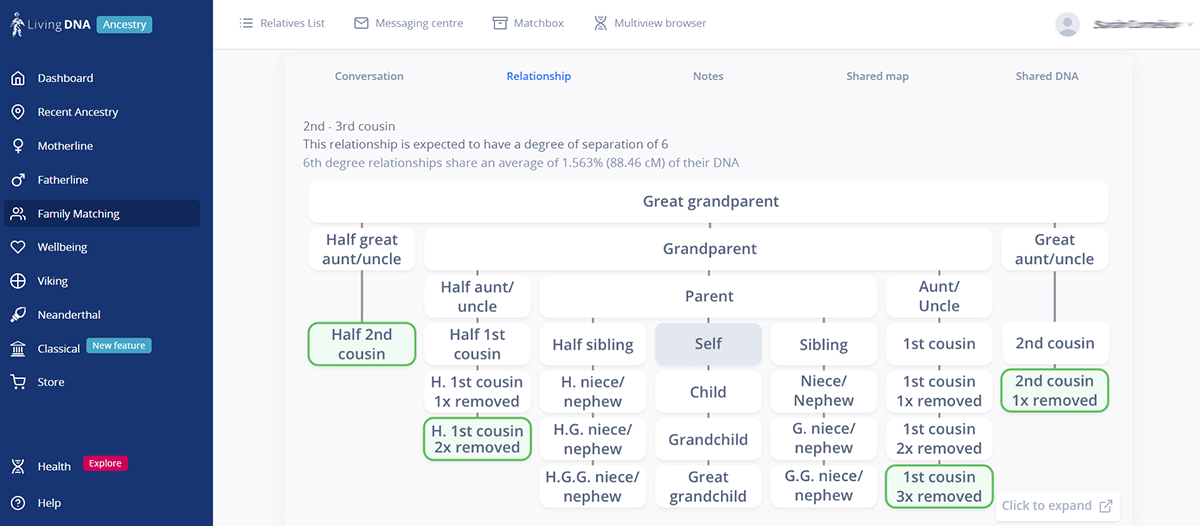
The relationship tab is fantastic for genealogy newbies, who many not understand how different levels of relatives could be related. This graphic gives you a broad overview of how your level of matches could fall within your family tree, which helps with your research. When I scrolled down in this tab, I found a list of all the Living DNA customers that this particular match and I have in common.
Shared Maps
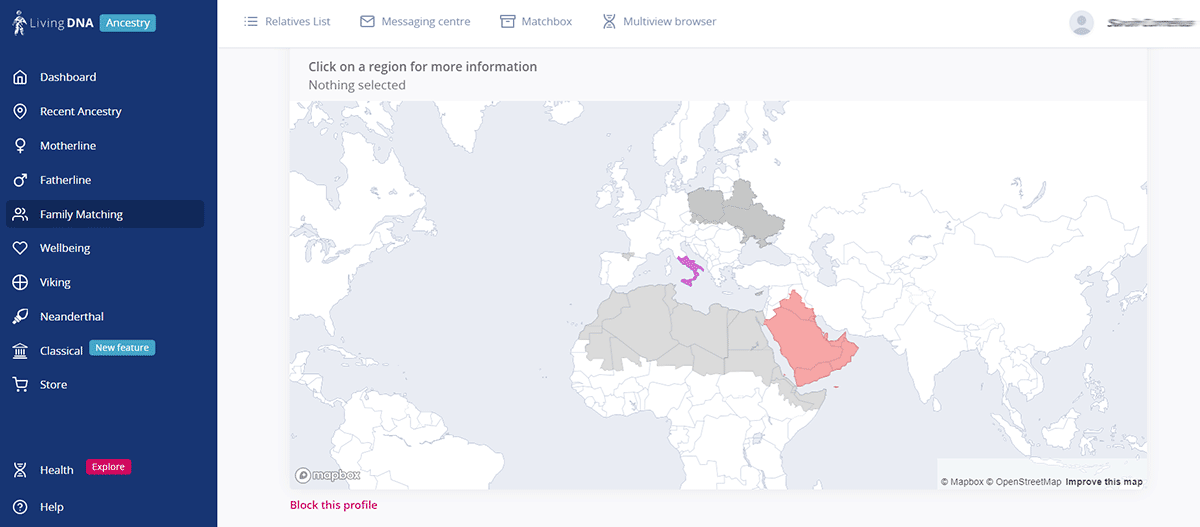
Another interesting tab within Family Matching is the Shared Map feature. It gives you a color-coded map of where you and the specific match you’re investigating share regional ancestors. The colored areas are the regions you share with your match. When I clicked on each region, Living DNA provided a percentage of how much DNA this match has (e.g., Southern Italy 36.2% and Arabia 7.2%) which is pretty accurate I think.
Additional Family Matching Tools
Other features in the Family Matching section include Living DNA’s new Chromosome Browser. This tool allows you to visually explore genetic data across chromosomes. For example, you can choose one or more family matches and compare your DNA segments. Serious genealogists use chromosome browsers to provide more clues about possible ancestors when they’ve hit a dead end with other methods.
You can also make notes within each match’s profile to return to later if you need to follow up with any information you’ve discovered. While all of these tools are super helpful, I find that Living DNA lacks a built-in family tree builder.
Upgrades Available After You Test
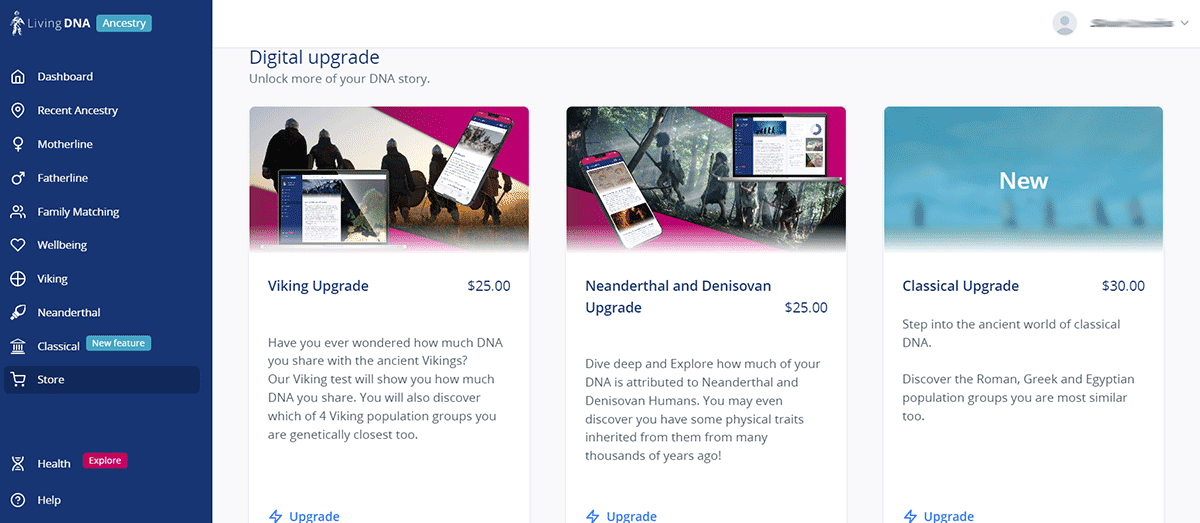
If you take the basic autosomal ancestry test, are pleased with your results, and want to learn more, Living DNA makes it easy. On the left tab, simply click on “Store,” and you’ll see digital upgrades available to you, as well as the opportunity to purchase additional kits at discounted prices. For me, these upgrades included:
- Viking Upgrade ($25): Shows you how much DNA you share with Vikings and which of the four Viking population groups you are genetically closest to.
- Neanderthal and Denisovan Upgrade ($25): See how much of your DNA is attributed to Neanderthal and Denisovan Humans, how you compare to other people, and more.
- Classical Upgrade ($30): Discover the ancient Greek, Roman, and Egyptian population groups you are most similar to, with percentile scores for each group.
- Wellbeing Upgrade ($30): See your body’s genetic response to fitness and nutrition and discover reports and advice on diet intolerances, vitamin absorption levels, and more. See below for more information about the Wellbeing kit.
What Can Living DNA’s Wellbeing Kit Tell You?
We did not test out Living DNA’s Wellbeing analysis but we wanted to give you an idea of what it can tell you. Keep in mind that this kit (or upgrade) doesn’t analyze your DNA for disease-risk genetic mutations like 23andMe does. Rather, this kit analyzes your DNA for about 15 different traits related to nutrition and exercise. Here’s some of what you can learn from this test.
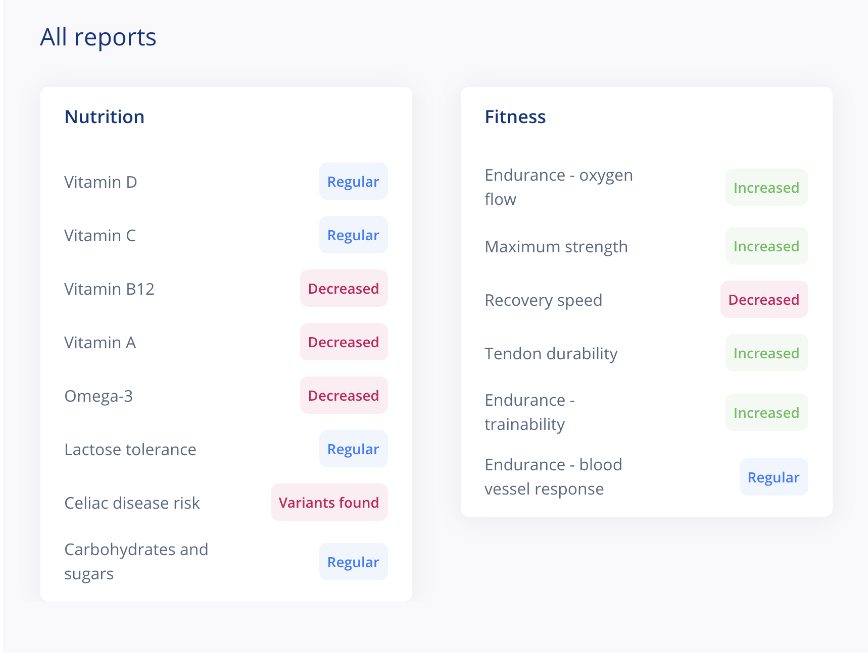
- Vitamin absorption levels: Analyzes some genetic variants that can impact the way in which your body metabolizes vitamins A, C, D, and B12 and omega-3 fatty acids.
- Food metabolism: See if you have genetic mutations that may cause lactose intolerance, gluten intolerance (celiac disease risk), and sensitivities to carbohydrates and sugar.
- Exercise: Gain insights into your body’s response to fitness, including oxygen flow, muscle strength, tendon durability, exercise recovery speed, and more.
Not sure Living DNA’s Wellbeing Kit is the right fit for you? See our reviews of the best DNA tests for health and diet to see how it compares.
Customer Feedback
As part of our in-depth review process, we scour the web for consumer feedback about each company we write about. Below you’ll see a sampling of both positive and negative opinions we found from other customers about Living DNA.
Praise
I bought a Living DNA kit for myself and i wasn’t dissapointed. Really really interesting report detailing geographical area of my DNA as well as maternal and paternal info. I had purchased a kit from another well known DNA company a few years ago and thier report was no way as detailed as this one from Living DNA. In my humble opinion i think its great.
– Mr. Geoffers, Trustpilot 02/18/2024
After less-than-pleasant experiences with a few of the “big names” in the DNA testing business, I was unprepared for the sterling level of service I received from Living DNA during multiple interactions with them, via email and live chat. Live chat with a real knowledgeable person (who actually has answers!) at the company? Absolutely. Friendly responses, fast solutions, and answers to every possible question I had? Yes! And when it comes to their solutions, affordable prices without cutting corners on features or quality? That’s the third gold star, and they’ve earned it with flying colors. Needless to say, I’m recommending them every chance I get. I’ve been doing genealogy research since 1991, and Living DNA is my favorite by far when it comes to DNA testing.
– Matthew J., Trustpilot 12/11/2023
Complaints
Totally inaccurate results. This has just been a complete waste of time and money and for what can only be described as a tiny amount of information anyway. Took a test with Ancestry at the same time and I could see straightaway that their results were accurate, pinpointing exactly my English results to the North West of England, with 43% to Scotland and a small percentage to Northern Ireland. LivingDNA have ignored Scotland and the North West of England completely and randomly split the English results into the rest of England. Feels almost like they’ve been analysing someone else’s DNA.
– Janet, Trustpilot 09/25/2023
Ordered the kit and received it quickly. I sent it back within a week and started watching the status. It never changed from “En Route”. I reached out and was basically told that it either got lost or I didn’t put the label on it right. I was mailed a new test and tried again. I verified (have photo evidence) that I attached the label correctly and I tracked the shipping this time. It made it just fine to the center in the US, but then was “en route” for 4 weeks again. I basically got told that it was either lost or the label was missing…again. I asked for a refund and was promptly granted one.
I don’t know where my samples ended up. And I definitely have a lot of reservations about trying any company like this again. Very disappointing
– Jessica K., Facebook 06/06/2023
How Does Living DNA Compare?
Here’s a brief overview of how Living DNA’s features compare to some of the top DNA ancestry tests. Note: the information below is for each company’s basic autosomal DNA test kit for ancestry.
| Living DNA | AncestryDNA | FamilyTreeDNA | 23andMe | MyHeritage | |
|---|---|---|---|---|---|
| DNA Database Size | 300,000 | 22 million | 2 million | 13 million | 7.9 million |
| # Of Geographical Regions | 150 | 2,600 | 90 | 2,750 | 2,114 |
| Maternal Haplogroup | |||||
| Paternal Haplogroup | |||||
| Family Matching | |||||
| Online Forums | |||||
| Pricing | $124 | $99 | $79 | $119 | $89 |
Frequently Asked Questions
Here are some questions consumers often ask about Living DNA. Don’t see your question here? Hit us up in our comments.
Is Living DNA Accurate?
For ethnicity breakdowns, the answer to this question is: it depends on where you’re ancestors lived. They don’t cover nearly as many geographical regions as some other top tests do. Family matching with Living DNA is accurate; however, because their DNA database is so small, you likely won’t find nearly as many family member matches as you can with AncestryDNA or 23andMe.
It’s a numbers game — any company can only provide you with DNA matches from customers who have tested with their company. Still, you never know what relatives you may discover with any DNA testing service.
Does Living DNA’s Results Include A Migration Map?
Living DNA does include migration maps for your haplogroups; however, I wish they could be more detailed and interactive.
Can You Upload Raw DNA Data To Living DNA?
Yes, Living DNA allows you to upload raw DNA results from several companies. Acceptable file types include .txt, .csv, .zip, and .gz. This gives you free access to their Family Matching service and basic ancestry results. To see full ancestry results, you’ll need to pay a fee of around $35. You can upload results from:
- AncestryDNA
- 23andMe
- MyHeritage
- FamilyTreeDNA (Family Finder)
- Gene by Gene
- Genographic (Geno 2.0)
What Does Living DNA Do With Your Genetic Data & DNA Sample?
Living DNA stores genetic information separately (and securely) to any other personal information you share with them (address, email, credit card information, etc.). Living DNA doesn’t sell your data with any third parties (e.g., insurance companies).
The company also states, “We will not share your personal information with law enforcement agencies unless we believe that we are legally compelled to do so.” This policy is in line with those of AncestryDNA, 23andMe, and other top services. They say they securely store your DNA sample for up to 10 years.
Is Living DNA Worth It?
If you’re looking for specific ethnicity breakdowns in the UK and Ireland (and Africa to a certain extent), Living DNA could be an excellent option for you. However, in other parts of the world, it’s hit or miss. Living DNA doesn’t have nearly the number of geographical region breakdowns as AncestryDNA and other services. Likewise, Family Matching with Living DNA is extremely limited due to its very small database of customers who have tested with this service. See how Living DNA compares to other top companies in our reviews of AncestryDNA, 23andMe, and FamilyTreeDNA.
Have you done other DNA tests for ancestry or health? Did you uncover any surprises? Let us know in the comments!
Why Trust Safe Smart Living?
This review was a collaborative effort between test-taker Sadie Cornelius and Sally Jones, our team’s DNA and ancestry expert. Sally has over 20 years of experience in human health sciences communications. She has extensively interviewed and reported on many of the world’s top scientists in such fields as genetics, cancer, infectious diseases, and much more. She’s also conducted genealogical research into her family’s history for years. Sadie and Sally are part of Safe Smart Living’s professional team of experts who test and research products to make our lives smarter and safer for us, our families, and our readers.

